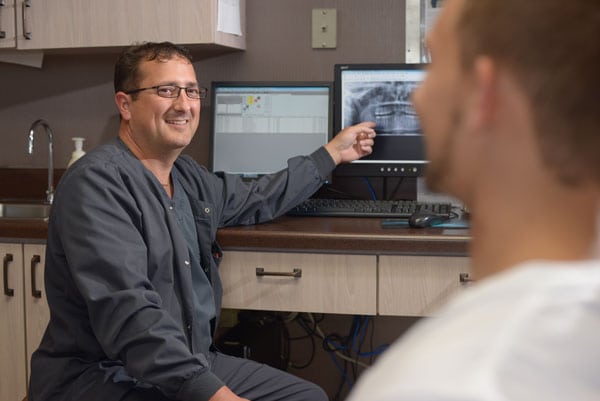Bone Grafting
Over a period of time, the jawbone associated with missing teeth atrophies or is resorbed. This often leaves a poor amount of quality bone left for the placement of dental implants. Today, we can grow new bone where needed through a process called bone grafting. This not only permits us to replace missing teeth with dental implants, but it gives us the opportunity to restore the aesthetic appearance of your jaw and overall facial structure.
Bone grafts can repair implant sites with inadequate bone structure due to previous extractions, gum disease, or injuries. The bone is either obtained from a tissue bank or your own bone is taken from the jaw, hip, or tibia (below the knee). In addition, special membranes may be utilized that dissolve under the gum and protect the bone graft and encourage bone regeneration. This is called guided bone regeneration or guided tissue regeneration.

Minor Bone Grafting
For a minor bone graft, say in the case of a lost tooth, sterile human bone granules, or synthetic scaffolding material are packed into the incision against the reduced bone area. The material is covered with a protective collagen membrane and typically closed with a few stitches. Over the next several weeks, bone replaces the filler material and preserves the necessary bone mass to allow for a dental implant. The insertion of a dental implant will preserve the bone indefinitely.
Minor bone grafts are usually performed in the clinic at Bay Oral Surgery & Implant Center with local anesthesia or sedation for comfort during surgery.
Major Bone Grafting
Major bone grafts are typically performed to repair defects of the jaws. These defects may rise as a result of traumatic injuries, tumor surgery, or congenital defects. Large defects are repaired using the patient’s own bone. This bone is harvested from a number of different sites depending on the size of the defect. These procedures are routinely performed in an operating room and require a hospital stay.
Platelet Rich Plasma Therapy
Platelet rich plasma (PRP) is a by-product of blood (plasma) that is rich in platelets. During the healing process, the body rushes many cells and cell-types to the wound in order to initiate the healing process. One of those cell types is platelets. Among other functions, platelets form blood clots and release growth factors into the wound. These factors assist the body in repairing itself by stimulating stem cells to regenerate new tissue. The more growth factors released into the wound, the more stem cells are stimulated to produce new tissue. Overall, the process of PRP therapy allows the body to heal faster and more efficiently.
A subfamily of one of these growth factors is bone morphogenic protein (BMP). BMP has been shown to induce the formation of new bone in research studies in animals and humans. By adding PRP and bone substitute particles to the site of a dental implant, surgeons can now grow bone more predictably and faster than ever before.
To see if you may need a bone graft, schedule a consultation with an oral surgeon.
